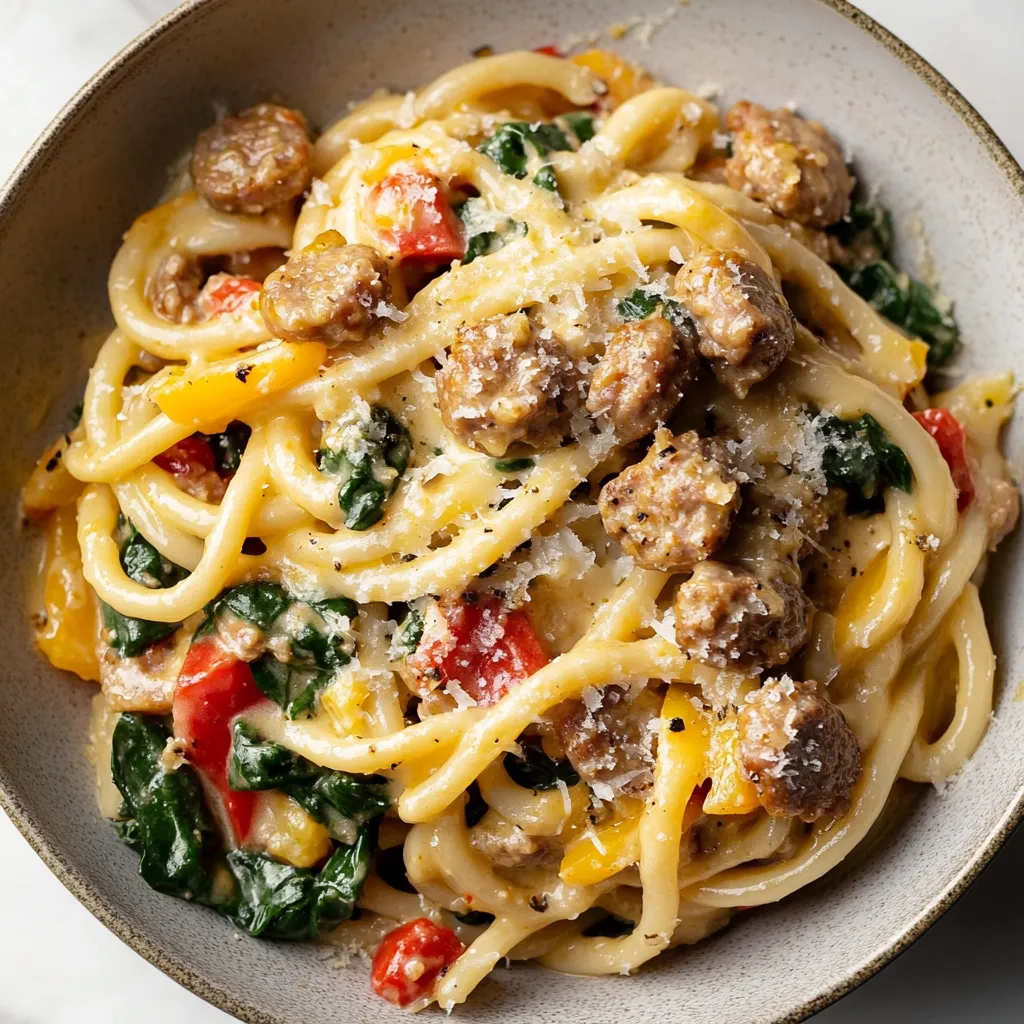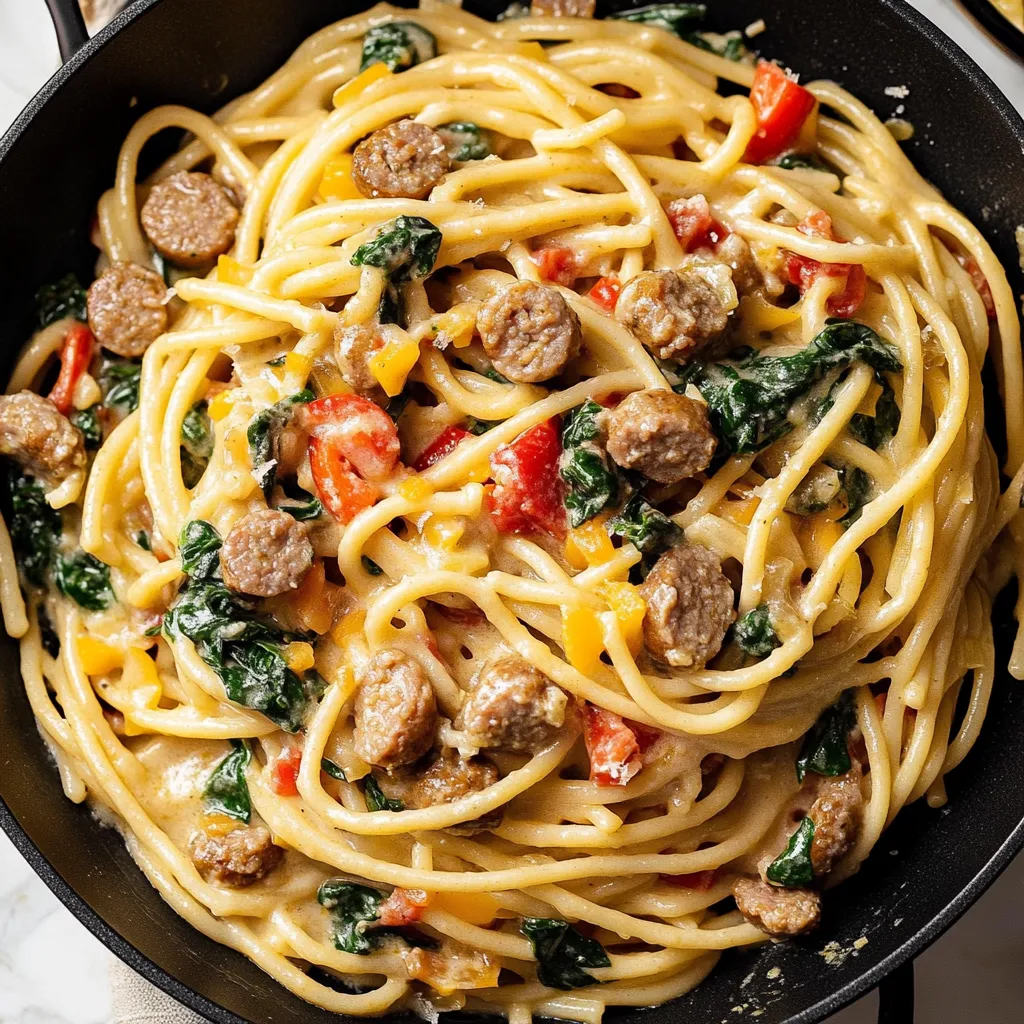 Pin it
Pin it
This indulgent creamy sausage and peppers pasta transforms the beloved Italian-American classic into a restaurant-worthy dish that's rich, satisfying, and surprisingly approachable. Tender bell peppers and caramelized onions meld with savory Italian sausage in a velvety cream sauce that perfectly coats each strand of pasta. The addition of fresh spinach and a touch of Dijon mustard elevates this comfort food to something truly special, making it the perfect Friday night treat or impressive dinner party dish.
I made this for my in-laws last weekend, and my father-in-law, who's quite the pasta connoisseur, declared it "better than anything he's had at our local Italian restaurant!" My teenage daughter, who typically picks peppers out of everything, cleaned her entire plate and asked when I'd make it again.
Ingredients
- Bucatini pasta: This thick, spaghetti-like pasta with a hole through the center is perfect for capturing the creamy sauce. Its slightly rough texture helps the sauce cling to every strand.
- Italian sausage: Provides the savory, seasoned protein base that defines this dish. Whether you use mild or spicy, the fennel and herb notes in good Italian sausage are essential to the flavor profile.
- Bell peppers: Add natural sweetness, vibrant color, and tender texture when properly cooked. Red and yellow peppers work best for their sweetness and visual appeal.
- Sweet onion: Creates a caramelized base layer of flavor when cooked slowly. Vidalia or other sweet varieties work best as they become more pronounced and mellow as they cook.
- Heavy cream: Forms the luxurious base of the sauce, providing richness and body that coats the pasta beautifully. Its fat content is crucial for proper thickening and mouthfeel.
- Flour: Acts as a thickening agent that helps create a sauce with the perfect consistency—not too thin that it pools, not too thick that it becomes gluey.
- Dijon mustard: The secret ingredient that adds depth and subtle tang without being identifiable. It enhances all the other flavors and prevents the sauce from being one-dimensional.
- Fresh spinach: Contributes color, nutrition, and a fresh element that lightens the richness of the cream sauce. Baby spinach wilts quickly and integrates seamlessly.
- Garlic: Provides aromatic depth that's essential to Italian flavors. Fresh garlic adds brightness that dried garlic simply can't match.
- Butter and olive oil: Work together to create the perfect cooking medium—olive oil for flavor and high-heat cooking, butter for richness and browning.
Instructions
- Step 1:
- Cook the pasta properly by bringing a large pot of well-salted water to a rolling boil. Add 12 ounces of bucatini (or your preferred long pasta) and cook according to package directions until al dente—typically 1-2 minutes less than the package suggests since the pasta will continue cooking in the sauce. Before draining, reserve 1/2 cup of the starchy pasta water, which will help bind the sauce to the pasta later. Drain the pasta but don't rinse it—you want to maintain the surface starch that helps the sauce adhere.
- Step 2:
- Brown the sausage perfectly by heating 1 tablespoon of olive oil in a large skillet over medium-high heat. Add 1 pound of Italian sausage (removed from casings if using links) and cook, breaking it up with a wooden spoon into bite-sized pieces. The key here is to let the sausage develop a nice brown crust before stirring—this caramelization adds significant flavor to the dish. Cook for about 6-8 minutes until the sausage is cooked through and nicely browned. Transfer the cooked sausage to a paper towel-lined plate, leaving the flavorful drippings in the pan.
- Step 3:
- Caramelize the vegetables by adding the sliced onions and bell peppers to the same skillet with the sausage drippings. This is where patience pays off—cook the vegetables over medium heat for 10-12 minutes, stirring occasionally, until the peppers are very soft and the onions are golden brown. Don't rush this step by turning up the heat, as slow cooking develops the natural sugars in the vegetables, creating a sweet, complex flavor foundation. The vegetables should look almost caramelized when done.
- Step 4:
- Create the sauce base by adding 2 tablespoons of butter to the caramelized vegetables. Once melted, add 3 cloves of minced garlic and cook for about 30 seconds until fragrant. Sprinkle 2 tablespoons of flour over the vegetables and stir continuously for about 1 minute to cook out the raw flour taste. This creates a roux that will thicken your sauce without any lumps.
- Step 5:
- Build the cream sauce by slowly pouring in 1 cup of heavy cream while stirring constantly to prevent lumps from forming. Add 1 teaspoon of Dijon mustard and stir until smooth. Allow the sauce to simmer gently for 2-3 minutes until it begins to thicken and coats the back of a spoon. The sauce should be creamy but still pourable—if it becomes too thick, thin it with a splash of the reserved pasta water.
- Step 6:
- Combine everything together by returning the cooked sausage to the skillet with the cream sauce. Add the drained pasta and 3 cups of fresh baby spinach, tossing everything together with tongs. The heat from the pasta and sauce will wilt the spinach almost immediately. If the sauce seems too thick, add the reserved pasta water a little at a time until you achieve the perfect consistency—the sauce should coat the pasta without being gluey or pooling at the bottom of the pan.
- Step 7:
- Season and serve by tasting and adjusting with salt and freshly ground black pepper as needed. Remember that the sausage and pasta water already contribute salt, so taste before adding more. Serve immediately while hot, topped with freshly grated Parmesan cheese and perhaps a light sprinkle of red pepper flakes for those who enjoy a bit of heat.
 Pin it
Pin it
I discovered through trial and error that adding the spinach at the very end, rather than cooking it with the vegetables, keeps it bright green and prevents it from becoming mushy. My Italian grandmother always said that vegetables should look like jewels in pasta dishes, not like they've been forgotten and overcooked—this technique honors her wisdom perfectly.
Perfecting the Sausage Selection
The quality of Italian sausage significantly impacts the final dish. Look for sausages with a good balance of meat and fat (about 80/20 ratio) and avoid overly lean varieties that can become dry and crumbly. Sweet Italian sausage provides the classic flavor profile, but spicy Italian adds a lovely heat that complements the cream sauce beautifully. For the best flavor, buy sausages from a good butcher or Italian deli where they're made fresh. If using pre-packaged sausages, check the ingredient list—the best ones contain pork, salt, fennel, and other spices without excessive fillers or preservatives. When removing sausage from casings, use a small knife to slit the casing lengthwise, then peel it away—the meat should come out easily. If you're using ground Italian sausage meat instead of links, look for meat that's not too finely ground; a slightly coarser texture provides better mouthfeel in the finished dish.
Mastering the Cream Sauce Technique
Creating a perfect cream sauce without lumps or separation requires attention to technique. The flour-and-butter roux must be cooked for at least a full minute to eliminate the raw flour taste—this step can't be rushed. When adding the cream, pour it in gradually while whisking constantly; adding it all at once can cause lumps or temperature shock that leads to separation. The sauce should simmer gently rather than boil vigorously, as high heat can cause dairy to curdle. If your sauce does separate (though following these steps should prevent this), remove it from heat and whisk in a tablespoon of cold cream, which often brings it back together. The Dijon mustard not only adds flavor but also acts as an emulsifier, helping to stabilize the sauce. For an even richer sauce, some cooks like to add 2 tablespoons of cream cheese along with the heavy cream—this creates an incredibly silky texture, though it's certainly not necessary for delicious results.
Vegetable Preparation Tips
The key to outstanding sausage and peppers pasta lies in properly preparing the vegetables. When slicing bell peppers, aim for strips about 1/4-inch wide—too thin and they'll overcook and become mushy, too thick and they won't soften properly. Remove all seeds and white membranes, which can add bitterness. For onions, slice them uniformly (about 1/4-inch thick) so they cook evenly. The slow caramelization process transforms sharp, pungent onions into sweet, mellow additions that enhance rather than overpower the dish. If you're short on time, you can increase the heat slightly, but watch carefully to prevent burning, which would add unwanted bitter notes. Some cooks like to add a pinch of sugar to help the caramelization process, though it's not necessary if you're cooking patiently. The vegetables are done when the peppers are completely tender and the onions are golden brown with some caramelized edges.
I developed this recipe after years of making the classic sausage and peppers combination but wanting something more elegant for dinner parties. The addition of cream sauce transforms familiar flavors into something special enough for guests yet comforting enough for family dinners. What makes this dish memorable is the balance—the richness of the cream sauce, the sweetness of properly caramelized vegetables, the savory depth of good sausage, and the fresh pop of spinach all work together harmoniously. My family now considers this my signature pasta dish, and I've noticed how it brings everyone to the table with anticipation. There's something deeply satisfying about taking simple, readily available ingredients and transforming them through technique into something that tastes like it came from a high-end Italian restaurant.
Frequently Asked Questions
- → Can I use ground beef instead of sausage?
- Yes, ground beef works well but you'll want to add some Italian seasoning for extra flavor since sausage has built-in spices.
- → What pasta shape works best for this recipe?
- Bucatini is great, but penne, rigatoni, or any pasta that holds sauce well will work perfectly fine.
- → How do I prevent the cream sauce from curdling?
- Keep the heat at medium or lower once you add the cream and don't let it boil hard. Gentle simmering is the key.
- → Can I make this recipe ahead of time?
- It's best served fresh, but you can prep the vegetables and cook the sausage earlier. Just reheat gently and add pasta water if needed.
- → What can I substitute for heavy cream?
- Half-and-half works but the sauce won't be as thick. You could also try milk with a bit of flour, though it won't be as rich.
- → How long does this pasta keep in the fridge?
- Leftovers will keep for 3-4 days in the refrigerator. Reheat gently on the stove with a splash of milk or pasta water.
